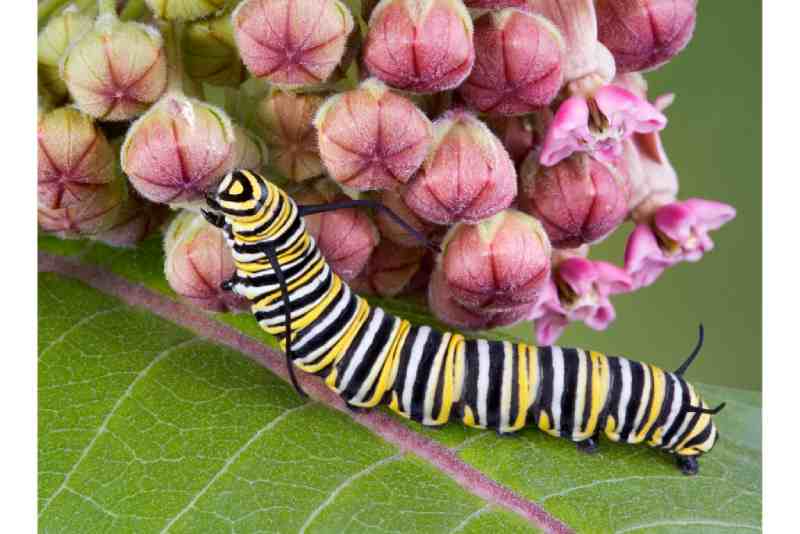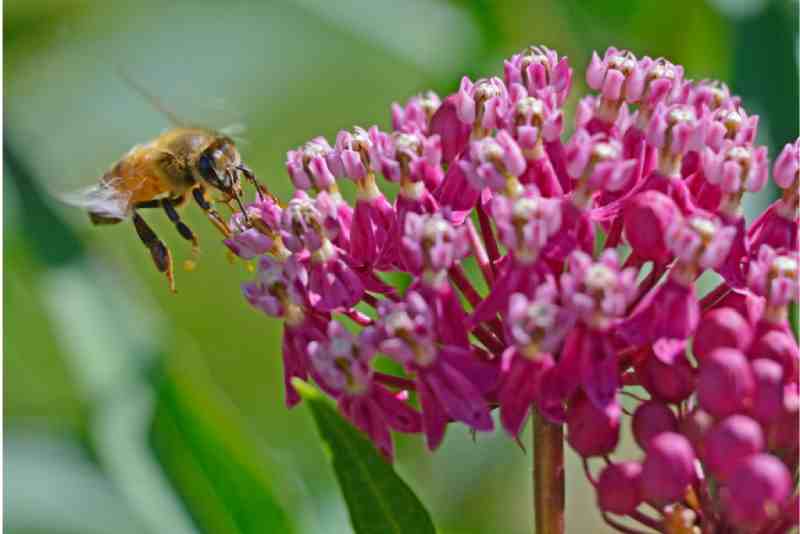As National Pollinator Week comes to a close, we wanted to give wing to a complicated issue: the relationship between tropical milkweed and monarch butterflies. Butterflies are critical pollinators; milkweed is vital to butterflies, so what can be so difficult? Well, some studies have found that one non-native species of milkweed – tropical milkweed – may have harmful effects on monarch butterflies. Scientists are still trying to discern exactly how these species impact one another, and some of these studies contradict each other. In this article, we will explore what those studies have found, why it matters, and what you can do about it.
The Life Cycle of the Monarch Butterfly

In order to understand the relationship between milkweed and monarch butterflies, we must first look at the life cycle of the monarch. These iconic orange and black butterflies can be found throughout the Americas. They can live as far north as southern Canada and spread down to Mexico where they spend their winters. Monarch butterflies are divided by the Rocky Mountains into two groups: Eastern monarchs and Western monarchs.
Let’s begin our journey with mature monarch butterflies in the northern Americas.
- Adult monarchs lay their eggs on milkweed plants.
- After hatching, the caterpillars feed on milkweeds for approximately two weeks. Then they tuck themselves away in their chrysalis (cocoon) to undergo a magnificent metamorphosis.
- Once they have emerged as captivating butterflies, monarchs spend their short life cycle feeding on nectar, searching for mates, and laying eggs.
- With each new generation, the monarch’s life cycle grows longer! The first generations have a life span of just a few weeks. The final generation of early fall can live up to 8 months! They will be the brave population to undergo the great migration south.
- Using environmental cues (such as changes in temperature and food supply), the monarchs will begin to travel south. The eastern monarchs will travel down to the mountains in Mexico. The western monarchs travel to southern California.
- Once they have reached their overwinter locations, monarchs do very little activity. They gather in clusters to stay warm and wait out the winter months without food and pause all reproduction.
- As spring comes the following year, the overwinter monarchs become sexually mature and lay a new generation of eggs. It is this new generation that will begin to travel its way back up north.
- It will take several generations of traveling before the monarchs make it back to the northern Americas. This means that no one monarch experiences the entire journey to and from their winter locations.
- Additionally, several generations never migrate at all in their life cycle. Yet the last generation of the summer and the first generations of spring instinctively know the route to and from their overwintering grounds!
The Relationship Between Monarchs and Milkweeds
Mature monarch butterflies lay their eggs exclusively on milkweed plants. In fact, milkweed is the only food source for monarch larvae and without it, the species would not be able to survive. Over the last twenty years, monarch populations have declined 90%! This is in part due to factors such as habitat loss, harmful herbicides, and depleting milkweed supplies.
Luckily for monarchs, there are over 70 species of native milkweeds available throughout the US and Canada. The majority of these species are perennial, meaning they become dormant in the winter and bloom again in spring or summer. The seasonality of milkweed is an environmental cue for monarchs to begin their annual migration. Enter the tropical milkweed, a non-native evergreen species.
When avid gardeners and butterfly lovers found out about the lack of milkweed, they got busy planting. When they went to the stores to buy seeds, tropical milkweed was the most readily available. It is one of the easiest milkweeds to grow, so it is popular among gardeners. In fact, many regional seeds are not available for restoration efforts, making tropical milkweed the only option for some people. This well-intended act led to an increase in tropical milkweed being planted.

Tropical Milkweed – Friend or Foe?
Tropical milkweed (Asclepias curassavica), also known as the sunset flower, is native to South and Central America, The Caribbean, and northern Mexico. Like most other milkweeds, tropical milkweed hosts monarch butterflies, and monarch butterflies are hosts to Ophryocystis elektroscirrha (OE). Ophryocystis elektroscirrha is a protozoan parasite transferred through spores on the outside of surfaces. It passed from monarch butterflies onto their eggs. As more butterflies land on an infected milkweed surface, the higher the concentration of Ophryocystis elektroscirrha spores. As monarch larvae consume the milkweed, the parasite replicates and builds up inside of it. It is believed that the parasite can reduce a butterflies ability to fly, and reproduce, and reduces their lifespans.
It is important to know that all milkweeds can be used to pass on OE; so what makes tropical milkweed the worst? Seasonality. As this subspecies survives the winter OE concentrations build up on the tropical milkweed – unlike its perennial cousins that die off until spring, taking the OE with them. Butterflies can handle low concentrations of this natural enemy, but some studies suggest the higher concentrations are resulting in declining monarch populations. This experiment was conducted by biologists who found significantly more infected monarchs at non-migratory sites versus than in the migratory population.
Another concern is that the presence of year-round tropical milkweed will disrupt the migratory patterns of monarchs. Monarchs rely on seasonal cues to begin their journey south, but if food is still available in the fall, they may not travel to their overwintering site at all. Thus, they consume more of the toxic OE and risk more deadly infections.
Contrarily, Jeffrey Glassberg, a biologist and president of the North American Butterfly Association asserts that tropical milkweed is not any more harmful than native milkweed species that contain OE. He cites that other studies were misguided and inconclusive. David James, an entomologist at Washington State University who conducted research in Australia claims that changes in temperature – likely due to climate change – are to blame for the declining monarch populations, not tropical milkweed.
While there has not been a unanimous conclusion about the deadliness of Ophryocystis elektroscirrha to monarch butterflies, most scientists agree that monarch butterfly populations are decreasing. Whether year-round toxic tropical milkweed is to blame, or harmful pesticides and climate change, it is important that we help our pollinators out!

What Can We Do?
While we may not be able to conclude whether or not tropical milkweed has a negative effect on monarch butterflies, we can still give these pollinators a helping hand!
- Plant Native Milkweeds: One way to avoid any issues is by planting milkweed that is native to your region. View this regional guide to learn more about the milkweeds suitable for your area! Local seeds may be more difficult to locate, but it’s better to take precautions when our pollinators are at risk.
- Cut it Back: If you already have tropical milkweed in your garden, we don’t recommend you go and pull them out of the ground. Instead, cut your tropical milkweed back before winter. By pruning it down you will be getting rid of the parasites that had accumulated. And don’t worry, the plant will regrow in the spring! That way they are still available as a food source for the larvae.
- Stay Educated: Since the verdict on tropical milkweed is up for debate and research is on-going, it is best to stay informed about any new research that comes out. By staying informed we can help our pollinators stay healthy and safe!
Subscribe to our blog!
Stay informed and up to date on the latest environmental topics with us.


